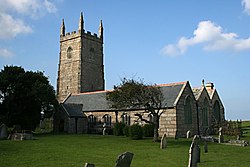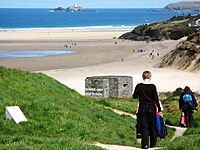Lelant
| Lelant | |
| Cornwall | |
|---|---|
 St Uny's Church, Lelant | |
| Location | |
| Grid reference: | SW544372 |
| Location: | 50°11’2"N, 5°26’24"W |
| Data | |
| Post town: | St Ives |
| Postcode: | TR26 |
| Dialling code: | 01736 |
| Local Government | |
| Council: | Cornwall |
| Parliamentary constituency: |
St Ives |
Lelant is a village in western Cornwall, on the west side of the Hayle Estuary, about two and a half miles southeast of St Ives and one mile west of Hayle. Its population at the 2011 census was 3,892.
The South West Coast Path passes through Lelant, along the estuary and above Porth Kidney Sands.
History
The village's name is derived from the Cornish lann and Anta, meaning church-site of Anta.[1] The earliest attested spelling is Lananta in about 1170.[2][3][4] Nothing is known about Anta, whether saint or founder. The parish church is dedicated to St Uny,[5] though Carbis Bay church is dedicated to St Anta.
Langdon (1896) records nine stone crosses in the parish, of which four are in the churchyard.
At one time Lelant was an important town and seaport. It had a market and a custom-house.[6] However when the estuary silted up, its trade was lost to St Ives and it declined into a small village. A parish terrier of 1727 describing the bounds of the glebe land states that about 50 acres of land, and the vicarage, were overwhelmed by sand. The terrier does not give a date but does say that it was not in the living memory of man.
In the spring of 1875, during the building of the railway line between St Erth and St Ives, several human skeletons, graves and a building were found by a gang of navvys. Observers of the building thought it was of an ecclesiastical nature, and it is possible that it is the site of a pre-Norman church, burial ground and the former Lelant town.[6]
Lelant was once an ecclesiastical parish, and the mother church of both Towednack and St Ives.[7] The parish church of St Uny's Church, Lelant is situated at the east end of the village on the edge of the towans and overlooking the West Cornwall Golf Club.

At Lower Lelant is a house called The Abbey which was built in the 16th century and renovated in the 18th.[7] In 1831 it was reported that much granite was quarried here, and that there were several tin mines nearby.[5] The family of Praed were landowners here for many centuries. The early 19th century politician and poet Winthrop Mackworth Praed was a member of the family, though he did not live in Cornwall.
Transport links

Lelant is on the short A3074 road that leads to Carbis Bay and St Ives, just to the north of the main A30 after it bypasses Hayle and where it swings south-westwards across country towards its end at Penzance on the south coast, about six miles away.
The village is served by two railway stations on the St Ives branch. The original station, Lelant, was built by the Great Western Railway in 1877 to serve Lelant village. Lelant Saltings was built in 1978 as park and ride station to relieve traffic congestion in St Ives and Carbis Bay.
Sport
- Golf: The West Cornwall Golf Club to the east of the village overlooking St Ives Bay and Godrevy Island. It is the oldest golf club in Cornwall.[8]
- Football: St Ives Town, who play their home matches at the Saltings, between the village and the railway station.
Outside links
| ("Wikimedia Commons" has material about Lelant) |
References
- ↑ Mills, A. D. (1991). The Popular Dictionary of English Place-Names. Parragon Book Service Ltd & Magpie Books. p. 208. ISBN 0-7525-1851-8.
- ↑ Archives of the Dean and Chapter of Exeter, Number 3672.
- ↑ Gover, J. E. B. (1948) The place names of Cornwall volume 6, pages 635-658
- ↑ Adam Maxwell: 'The real and true name of Lelant' – Lelant.info
- ↑ 5.0 5.1 Information on Lelant from GENUKI
- ↑ 6.0 6.1 Noall, Cyril (1964). "Nineteenth-Century Discoveries at Lelant". Cornish Archaeology Hendhyscans Kernow 3: 34-6.
- ↑ 7.0 7.1 Nikolaus Pevsner: The Buildings of England: Cornwall, 1951; 1970 Penguin Books ISBN 978-0-300-09589-0
- ↑ "West Cornwall Golf Club". Club Systems International. http://www.westcornwallgolfclub.co.uk/Home.aspx. Retrieved 4 April 2015.
